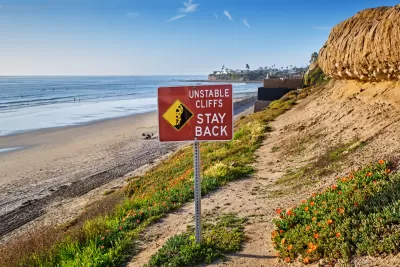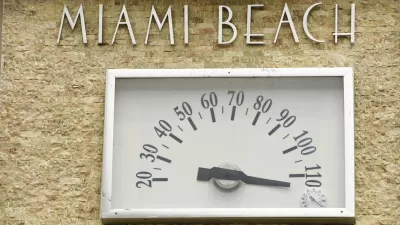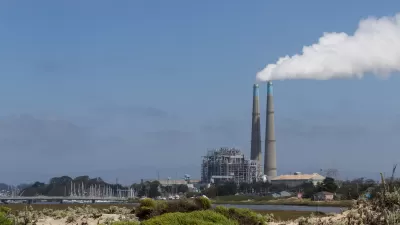The Biden Administration announced the second massive investment of federal funds for coastal resilience on June 6. The Inflation Reduction Act allocated $3.3 billion to NOAA. In March, the Infrastructure Investment & Jobs Act added $562 billion.

The National Oceanic and Atmospheric Administration (NOAA), a bureau within the U.S. Department of Commerce, is a major beneficiary of the Biden Administration's two signature climate, energy, and infrastructure laws that can easily be confused with each other.
On June 6, the “Commerce Department announced it will put $2.6 billion toward coastal climate resilience in funds from the Inflation Reduction Act (IRA),” reported Zack Budryk, who covers energy and environmental issues for The Hill.
The funds are part of $3.3 billion allocated to NOAA by the IRA. The Biden administration previously allocated about $562 million in coastal climate resilience in April through the Bipartisan Infrastructure Law [aka Infrastructure Investment and Jobs Act or IIJA].
Related in Planetizen:
- 'Inflation Reduction Act' a Mixed Bag for Climate Action, Planning Innovation, August 1, 2022
- Key Details of the $1.2 Trillion Federal Infrastructure Bill, November 15, 2021
“Under President Biden’s leadership, we are making the most significant direct investment in climate resilience in the nation’s history,” said U.S. Secretary of Commerce Gina Raimondo in the NOAA press release.
The historic $2.6 billion investment in climate resilience and coastal communities will help ensure communities, especially Tribes and vulnerable populations, have the resources and support needed to prepare, adapt and build resilience to weather and climate events as well as strengthen workforce development, marine resources, nature-based solutions, conservation, regional partnerships and Tribal priorities.
Biden joins the action
The president himself took the opportunity during a three-day trip to California to announce NOAA's newest program, the Climate Resilience Regional Challenge made possible by the aforementioned IRA investment.
“Standing in front of salt marshes at the edge of the San Francisco Bay on Monday, President Biden announced $600 million in funding for coastal communities building projects to protect against the impacts of climate change, as well as $2.3 billion to bolster electric grid resilience,” reported Danielle Echeverria for the San Francisco Chronicle on June 19.
Joined by Gov. Gavin Newsom, Peninsula congresswoman Anna Eshoo, Santa Clara County and Palo Alto elected officials and local activists at the Lucy Evans Baylands Nature Interpretive Center in Palo Alto, Biden said that the funding was part of his administration’s focus on “aggressive climate action” amid the devastating impacts of climate change, including wildfires, drought and floods in California.
“The Challenge is the first and largest funding opportunity released under the $2.6 billion Inflation Reduction Act climate resilience framework that the Department unveiled earlier this month,” according to NOAA's announcement on June 20.
The power grid resilience funding from the Infrastructure Investment and Jobs Act (IIJA) was announced by the U.S. Department of Energy last July.
Distinguishing the IRA and IIJA
What's notable about the climate resilience investments is that they focus largely on climate adaptation rather than mitigation of emissions. It was that focus that helped the IIJA to receive the support of 19 GOP senators on August 10, 2021, led in part by Sen. Bill Cassidy of Louisiana, enabling it to pass a Senate filibuster.
The IRA, on the other hand, bypassed the filibuster as a reconciliation bill on Aug. 7, 2022, receiving no GOP votes in either house. It remains a GOP target for repeal.
FULL STORY: Biden administration announces $2.6 billion toward coastal climate resilience

Trump Administration Could Effectively End Housing Voucher Program
Federal officials are eyeing major cuts to the Section 8 program that helps millions of low-income households pay rent.

Planetizen Federal Action Tracker
A weekly monitor of how Trump’s orders and actions are impacting planners and planning in America.

Ken Jennings Launches Transit Web Series
The Jeopardy champ wants you to ride public transit.

Driving Equity and Clean Air: California Invests in Greener School Transportation
California has awarded $500 million to fund 1,000 zero-emission school buses and chargers for educational agencies as part of its effort to reduce pollution, improve student health, and accelerate the transition to clean transportation.

Congress Moves to End Reconnecting Communities and Related Grants
The House Transportation and Infrastructure Committee moved to rescind funding for the Neighborhood Equity and Access program, which funds highway removals, freeway caps, transit projects, pedestrian infrastructure, and more.

From Throughway to Public Space: Taking Back the American Street
How the Covid-19 pandemic taught us new ways to reclaim city streets from cars.
Urban Design for Planners 1: Software Tools
This six-course series explores essential urban design concepts using open source software and equips planners with the tools they need to participate fully in the urban design process.
Planning for Universal Design
Learn the tools for implementing Universal Design in planning regulations.
Heyer Gruel & Associates PA
Ada County Highway District
Institute for Housing and Urban Development Studies (IHS)
City of Grandview
Harvard GSD Executive Education
Toledo-Lucas County Plan Commissions
Salt Lake City
NYU Wagner Graduate School of Public Service





























